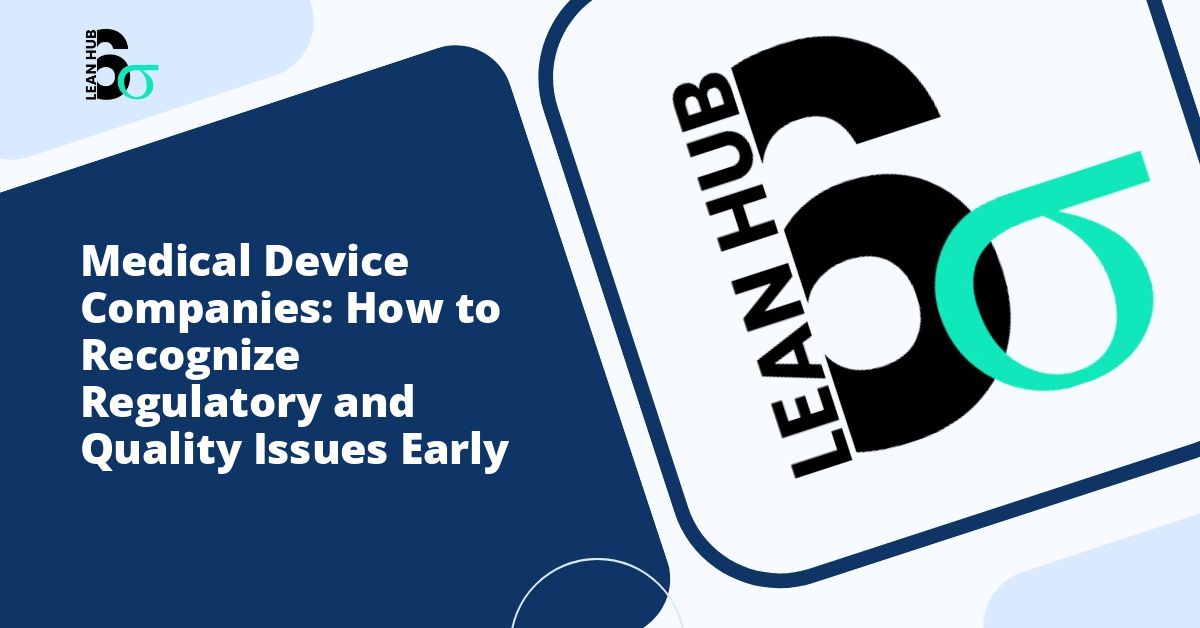The medical device industry operates under some of the most stringent regulatory requirements in the world, and for good reason. These products directly impact patient safety and healthcare outcomes. For medical device companies, the ability to identify regulatory and quality issues before they escalate into costly recalls, regulatory actions, or worse, patient harm, represents a critical competitive advantage and ethical imperative.
Understanding how to recognize potential problems early in the product lifecycle can save companies millions of dollars, preserve their reputation, and most importantly, protect patients. This article explores practical strategies and methodologies that medical device manufacturers can implement to detect regulatory and quality issues at their earliest stages. You might also enjoy reading about The Champion's Role in the Recognize Phase: Your Complete Guide to Lean Six Sigma Success.
The High Stakes of Medical Device Quality
Medical device failures carry consequences that extend far beyond financial losses. When quality issues slip through undetected, they can result in product recalls, warning letters from regulatory bodies like the FDA or EMA, consent decrees, and in severe cases, serious patient injuries or fatalities. The reputational damage alone can take years to repair, while the direct costs of recalls often run into millions of dollars. You might also enjoy reading about Recognizing Process Inefficiencies in Banking Operations: A Lean Six Sigma Approach.
Recent industry data shows that the average cost of a medical device recall exceeds $8 million when accounting for direct expenses, lost sales, and remediation efforts. Beyond these tangible costs, companies face intangible losses including diminished market confidence, strained relationships with healthcare providers, and increased scrutiny from regulatory agencies. You might also enjoy reading about What is the Recognize Phase in Lean Six Sigma? A Complete Guide for Beginners.
The key to avoiding these scenarios lies not in responding to problems after they occur, but in developing robust systems that identify potential issues during the earliest possible stages of development, manufacturing, and post-market surveillance.
Implementing Structured Problem Recognition Systems
One of the most effective approaches to early issue detection involves implementing structured problem-solving methodologies. The integration of lean six sigma principles into medical device quality systems provides a data-driven framework for identifying variations and potential failures before they impact product quality or regulatory compliance.
The Recognize Phase in Quality Management
The recognize phase represents the critical first step in any quality improvement initiative. During this phase, organizations systematically identify problems, opportunities for improvement, and potential risks within their processes and products. For medical device companies, the recognize phase involves several key activities:
- Collecting and analyzing data from multiple sources including manufacturing metrics, supplier performance, customer complaints, and post-market surveillance
- Conducting regular process audits and assessments to identify deviations from established procedures
- Reviewing regulatory guidance documents and industry standards to ensure ongoing compliance
- Engaging cross-functional teams to capture diverse perspectives on potential issues
- Establishing clear criteria for what constitutes a significant quality or regulatory concern
When properly executed, the recognize phase enables companies to surface issues that might otherwise remain hidden until they develop into major problems. This proactive approach contrasts sharply with reactive quality management, where organizations only address problems after they have manifested in customer complaints or regulatory observations.
Key Indicators of Emerging Regulatory Issues
Experienced quality professionals know that regulatory problems rarely appear suddenly. Instead, they typically develop gradually through a series of warning signs. Recognizing these indicators early provides companies with the opportunity to intervene before minor concerns evolve into serious compliance gaps.
Documentation and Record-Keeping Patterns
Incomplete, inconsistent, or delayed documentation represents one of the most common precursors to regulatory issues. When review cycles extend beyond established timelines, when approval signatures are missing, or when corrections are not properly documented, these patterns suggest underlying process weaknesses that regulators will inevitably discover.
Medical device companies should monitor documentation metrics closely, including the time required to complete batch records, the frequency of documentation errors, and the rate of deviation reports. Increasing trends in any of these metrics warrant immediate investigation.
Training and Competency Gaps
Another early indicator of potential problems appears in training records and competency assessments. When employees consistently require retraining on the same procedures, when assessment scores decline, or when training completion rates fall behind schedule, these signs point to knowledge gaps that could lead to quality failures or regulatory non-compliance.
Regular analysis of training data can reveal these patterns before they result in actual product defects or process failures. Companies that treat training metrics as leading indicators of quality performance position themselves to address competency issues proactively.
Quality Metrics That Signal Trouble Ahead
Effective early recognition of quality issues depends heavily on selecting and monitoring the right metrics. While lagging indicators like customer complaints and product returns certainly matter, leading indicators provide earlier warning of developing problems.
Process Capability Indices
Process capability studies reveal whether manufacturing processes can consistently produce products within specification limits. When capability indices begin to decline, even if products still meet specifications, this trend indicates that processes are drifting toward failure. Companies that monitor these metrics closely can intervene with process improvements before defective products are manufactured.
Supplier Quality Trends
For medical device manufacturers that rely on external suppliers for components or materials, supplier quality metrics serve as crucial early warning indicators. Increases in supplier rejection rates, delivery delays, or certificate of analysis discrepancies often precede quality issues in finished devices.
Implementing robust supplier scorecards and conducting regular supplier audits helps companies identify supplier-related risks before they impact product quality. The recognize phase of lean six sigma methodology emphasizes the importance of understanding variation in incoming materials as a potential source of downstream quality problems.
Leveraging Technology for Early Detection
Modern quality management systems and data analytics platforms have transformed the ability of medical device companies to recognize issues early. These technological solutions enable real-time monitoring of quality metrics, automated alerts when parameters exceed control limits, and sophisticated trend analysis that reveals subtle patterns human reviewers might miss.
Cloud-based quality management systems can aggregate data from multiple sources including manufacturing equipment, environmental monitoring systems, laboratory instruments, and post-market surveillance databases. This integrated view enables quality teams to identify correlations between different data streams that might indicate emerging problems.
Artificial intelligence and machine learning algorithms are increasingly being applied to quality data analysis, with some systems capable of predicting potential failures before they occur based on historical patterns and current process data.
Creating a Culture of Early Recognition
While systems, metrics, and technology are essential, the human element remains central to effective early recognition of quality and regulatory issues. Companies must cultivate an organizational culture where employees at all levels feel empowered and encouraged to raise concerns without fear of negative consequences.
This culture of openness and transparency starts with leadership demonstrating genuine commitment to quality over production pressures or financial targets. When employees observe that reported concerns are taken seriously, investigated thoroughly, and result in meaningful improvements, they become more likely to report potential issues early.
Regular quality forums where cross-functional teams discuss trends, near-misses, and potential risks help democratize the recognize phase beyond the quality department. Manufacturing operators, maintenance technicians, and customer service representatives often observe early warning signs that quality professionals might not see, making their input invaluable.
Developing Proactive Response Protocols
Recognition alone provides no value unless coupled with effective response mechanisms. Medical device companies must establish clear protocols that define how the organization responds to identified concerns. These protocols should specify escalation paths, investigation requirements, interim risk mitigation measures, and timelines for resolution.
The goal is to create a seamless transition from recognizing a potential issue to implementing corrective and preventive actions. Companies that excel in this area often use structured problem-solving methodologies that guide teams through root cause analysis and solution development in a consistent, thorough manner.
Conclusion
The ability to recognize regulatory and quality issues early represents a fundamental capability for medical device companies operating in today’s complex regulatory environment. By implementing structured methodologies like lean six sigma, with particular emphasis on the recognize phase, companies can detect problems when they are still manageable rather than after they have escalated into major crises.
Success requires a combination of robust systems, relevant metrics, enabling technology, and most importantly, an organizational culture that values early detection and transparent communication about potential issues. Companies that master these elements not only reduce their risk exposure but also build sustainable competitive advantages through superior product quality and regulatory compliance.
The investment in early recognition capabilities pays dividends many times over through avoided recalls, maintained regulatory standing, protected reputation, and most importantly, enhanced patient safety. In an industry where the stakes could not be higher, the ability to see problems coming and address them proactively is not just good business practice but an ethical imperative.








